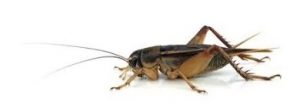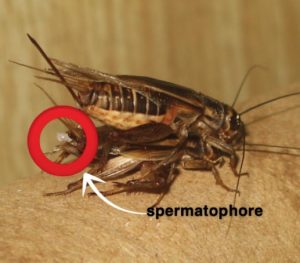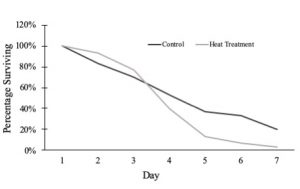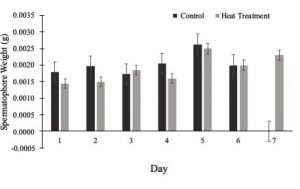2 How does climate change impact reproductive effort in wildlife?
Sophie Gray and Erin Heapy

Research Question:
How do global warming and climate change-induced heat waves affect reproduction in A. domesticus crickets?
Abstract:
The melting of the ice caps, a rise in the temperature of oceans, and less annual snowfall are all indicators of climate change. Global warming has resulted in wildlife experiencing numerous difficulties including food scarcity and loss of habitat. In this experiment, we determined how a climate change-induced heat wave affects energy spent on reproduction in Acheta domesticus crickets. We did this by simulating a heat wave for a test group, while we held a control group at a constant temperature. Their spermatophores- the sperm-containing packages males produce to pass to females during mating- were collected and analyzed from both groups. We weighed spermatophores and crickets daily and the data collected was used to determine how an increase in temperature affects reproductive efforts in these organisms. We found that there was a significant difference between the spermatophore sizes produced by heat treatment and control groups and that the heat treatment group demonstrated a higher death rate than the control group, suggesting that a terminal reproductive investment may be at work.
Key Terms:
- Climate Change: the steadily increasing trend, backed by extensive research, that has been seen among ecosystems, caused by human-driven emissions of greenhouse gases and pollution that have resulted in large-scale changes to weather patterns and increases in the average global temperatures.
- Heat Wave: An increasingly frequent phenomena that is a direct result of global warming, a heat wave is defined as a 6-day period of above-average temperatures with a maximum temperature above the 90th percentile for temperatures measured in previous years around the same time.
- Spermatophore: The reproductive mechanism of a male cricket, these are small, firm capsules containing sperm which the male passes to the female during mating. Males usually produce one every two days.
- Terminal Reproductive Investment: The idea that when faced with a thinning chance of survivorship, the individuals will channel their valuable energy into reproduction efforts.
Background:
Temperature increases, increased rainfall, and extinction of animals are just a few notable consequences of global warming. These changes have caused wildlife to experience a great deal of stress. Watch the video below to learn more about climate change and how it has impacted the animal kingdom!
https://www.youtube.com/watch?v=9h7P8gWpolQ
A potential consequence of climate change includes organisms having limitations on what they spend their energy on. For example, say you are sitting in the sun and eating ice cream, on a hot summer day. You suddenly realize you are overheated, dehydrated, and you begin to feel faint and you must decide if you run to the shade of a tree in one direction or head in the other direction to get a drink from a water fountain. What we see in wildlife is similar to this- organisms may put more energy towards surviving or reproducing, but they can’t do both. While we know the broad patterns of how climate change affects wildlife, we do not know specifically how it affects the energy spent on reproduction.
Insects are not able to regulate their body temperatures on their own and therefore rely on the temperature of their environment to heat and cool their bodies. With this in mind, Acheta domesticus crickets are an ideal model organism for our experiment because the effects of a higher environmental temperature will be very noticeable.
Spermatophores are very important for reproduction in A. domesticus. These tiny balls protect the sperm and are transferred to the female during mating. Additionally, spermatophores are full of seminal fluid proteins that aid in reproductive success by protecting the organism’s sperm and increasing its quality.
While spermatophores are necessary for reproduction, they take a lot of energy for organisms to produce. When presented with a source of stress, male crickets may produce a smaller spermatophore since energy will be spent to help it survive. Alternatively, a source of stress may cause the cricket to spend more energy on reproduction, producing a larger spermatophore, but dying in the process. To relate this back to our earlier example, this would be like if you decided to leave your ice cream in the sun and spend energy running to the water fountain. Your ice cream would melt, but you would have avoided heat exhaustion (if a cricket spent more energy on survival). Alternatively, you could finish your ice cream quickly. You would get to eat all of your ice cream, but you may faint before you are able to finish (if a cricket spent more energy on making a larger spermatophore, dying in the process). This is an example of a terminal reproductive investment.

In this study, we determined the effects of an increase in environmental temperature on reproductive investment in male A. domesticus crickets. We expected that when exposed to a heat wave, crickets would spend more energy on survival and produce smaller spermatophores with less protein. Alternatively, we expected that they may spend more energy on reproduction, produce larger spermatophores with higher protein contents, but die as a result. The findings of this study allow for us to have a better understanding of how organisms’ reproductive success and the continuation of the species may be hindered by this change in environment.
Methods:
- Our control group consisted of 45 male crickets with an additional 45 male crickets in the heat treatment group. We split these groups evenly between 3 trials.
Temperature Treatments
- We structured our heat wave in a way that mimics a naturally-occuring heat wave. Since A. domesticus are native to the midwest, we structured our experimental temperatures around a 2019 Indianapolis heat wave.
- We exposed the test group to a simulated heat wave by holding the environmental temperature at 31°C for the first day, raising the temperature to 34°C for the next 4 days, and then reducing it to 31°C for the last day.
- We held our control group at 28°C for the whole experiment to mimic temperatures these crickets typically experience in nature.
Spermatophores
- Prior to experimentation, we weighed each cricket and extracted and weighed any spermatophores that had been produced so we would have baseline data.
- We continued to weigh each cricket, collect spermatophores, and weigh the spermatophores each day of experimentation, approximately 24 hours apart.
- To extract the spermatophores, we placed each cricket in the freezer for ~4 minutes in order to sedate them before removing the spermatophore.
- We then measured the protein concentration of these spermatophores.
Results & Findings:
We found that the control group crickets lived longer than the heat treatment groups in all three trials. More specifically, the control group survived an average of 0.62 days longer than the experimental group. Additionally, in the control group, we observed a gradual decline in the number of surviving crickets as our experiment progressed, while the heat treatment group displayed a high death rate with a steep decline of surviving individuals as the experiment went on (Figure 1).
We also observed a significant difference in the weights of spermatophores produced by the control and heat treatment groups, with our heat treatment individuals producing larger spermatophores (Figure 2). This, along with the higher rate of death in the heat treatment group leads us to believe that heat treated individuals invested energy in reproduction, but died off sooner as a result. This suggests that a terminal reproductive investment is present in these organisms.
A larger spermatophore is associated with a higher protein content, so our results would suggest that global warming has a positive effect on these organisms and their reproduction. However, heat exposure causes some organisms to have lower sperm quality, resulting in decreased reproductive success and a shortened lifespan of their offspring. Therefore, although we observed an overall increase in size of spermatophores in heat treated individuals, this does not necessarily mean that the heightened reproductive efforts make reproduction more effective. More research is needed on this topic in order to determine how spermatophore quality is truly affected by heat treatment.


Future Research Direction:
- With such a high mortality rate, it was difficult to obtain data from a large number of individuals for the entirety of our experiment. This resulted in our trends potentially being skewed and fewer significant results identified. It would be beneficial to have a larger sample size in future work so that data could be collected from a greater number of individuals for the entire experimental period.
- Future work could also dive deeper into how heat treatment affects spermatophore quality as well as the quality of the offspring produced by heat treated individuals. This could be achieved by breeding heat treated individuals and observing their reproductive success and lifespan of the offspring produced.
- Rearing crickets in lab may be beneficial, as it would allow researchers to know exactly what age the crickets are when experimentation begins. This could help reduce the high mortality rate we observed by ensuring that no crickets are significantly older than the others and could die off sooner.
Significance:

